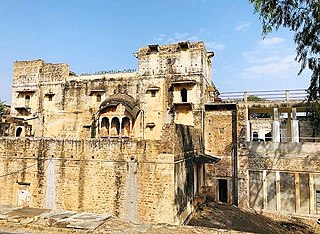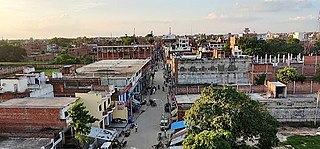Related Research Articles

Fatehpur Sikri is a town in the Agra District of Uttar Pradesh, India. Situated 35.7 kilometres (22.2 mi) from the district headquarters of Agra, Fatehpur Sikri itself was founded as the capital of the Mughal Empire in 1571 by Emperor Akbar, serving this role from 1571 to 1585, when Akbar abandoned it due to a campaign in Punjab and was later completely abandoned in 1610.
The Karmanasa River is a tributary of the Ganges. It originates in Kaimur district of Bihar and flows through the Indian states of Uttar Pradesh and Bihar. Along the boundary between Uttar Pradesh and Bihar it has the districts of Sonbhadra, Chandauli, Varanasi and Ghazipur on its left ; and the districts of Kaimur and Buxar on its right.
Muslim Rajputs or Musalman Rajpoots are the descendants of Rajputs in the northern regions of the Indian subcontinent who are followers of Islam. They converted from Hinduism to Islam from the medieval period onwards, creating various dynasties and states while retaining Hindu surnames such as Chauhan. Today, Muslim Rajputs can be found mostly in present-day Northern India and Pakistan. They are further divided into different clans.

Ghazipur district is a district of Uttar Pradesh state in northern India. The city of Ghazipur is the district headquarters. The district is part of Varanasi Division. The region of Ghazipur is famous mainly for the production of its unique rose-scented Spray called Gulab Jal, and for the tomb of the Governor General of British India, Lord Cornwallis, who died here. His tomb is situated in Western part of City, and is conserved by Archaeological Survey of India.
Gahmar is a village in India, located near the Ganges river in the Ghazipur district in the state of Uttar Pradesh. The village is 38 km from Ghazipur. The village has two post offices, and one Panchayat Bhawan. Gahmar is also known as the "Village of Soldiers".
Chainpur may refer to several places: History of chainpur The area of Chainpur in Kaimur district of Bihar was historically ruled by Sikarwar Rajputs.[4] A document called the Kursinama purports to trace the ancestry of the Chainpur family to Fatehpur Sikri where the family was driven out during the Turkic Muslim ruler Babur's conquest, when he won battle of Khanwa.
Jamuhar is a village in the Rohtas district of Bihar, India.
Babu Amar Singh was a revolutionary in the Indian Rebellion of 1857 and the brother of Babu Kunwar Singh, the zamindar of Jagdishpur.

The Gautam Rajputs is a Rajput clan belonging to the Ikshvaku dynasty with gotra Gautam, primarily found in the Indian states of Uttar Pradesh, Bihar and Madhya Pradesh along with states of Rajasthan and Gujarat.
Reotipur is a village located in the Ghazipur district of Uttar Pradesh, India. With a population of 28833, it is the largest village in Seorai Tehsil of the Ghazipur district.
The Ujjainiya Parmār are a Rajput clan that inhabits the state of Bihar.
Dildarnagar Kamsar or Kamsaar, is a Pargana or a region of 32 places around Karamnasa river in Ghazipur district, and Kaimur District of Uttar Pradesh, and Bihar, India. Of whom main mouzas being 19. It is a large settlement of pathans mostly Khanzada Pathans and Afghan Pathans.
Harihobans departed from the HeheyaKingdom are a clan of Rajputs that reside mainly at Bhojpur district of Bihar with a smaller community also present in Ballia district of Uttar Pradesh. They were the rulers of Bihiya and under the leadership of Ram Pal Singh.
The Chero dynasty or Chyavana dynasty was a polity that ruled the northern regions of the Indian subcontinent, corresponding to the present-day Indian states of Bihar, Uttar Pradesh, and Jharkhand, after the fall of the Pala Empire; their rule lasted from the 12th century CE to the 19th century CE.
Chainpuris a Town and corresponding community development block in Kaimur district of Bihar, India. It is located 11km west of Bhabua, the district headquarters of kaimur district .As of 2011, the village population was 11,306, in 1,653 households. The block population was 187,692, in 30,189 households. The main village Chainpur was also before known as Malikpur on the name of zamindar Malik Khan one of the descendants from the family of Bhabua. Chainpur was established in early 1600s. Chainpur was the capital of Chainpur Estate.
Maharaja Kam Dev Misir Urf Karam Singh (b.1438-1532) was a Sakarwar Rajput king and the ruler of the Pahargarh Estate, which mainly consisted of four cities in modern India, namely: Morena, Gwalior, Jhansi, Shivpuri. Kam Dev was the son of Maharaja Jay Raj Dev Singh who was the ruler of the Vijaypur Sikri estate, which was spread over 35000 km2.

Pahargarh Estate was a Zamindari estate under the surganty of the Lodi Dynasty, from 1441 to 1457, and later under the Mughal Empire, Jhansi State and British Raj. Pahargarh is located in Madhya Pradesh, in Morena District, India. It was ruled by the Sikarwar Rajput of Maharaja Zamindar family of Pahargarh who were the descendants of Rao Anup Dev Sikarwar or his grandson Maharaja Kam Dev Sikarwar. When Kam Dev Sikarwar shifted to Ghazipur District in 1530, the estate was handled by his second, third, and fourth sons' family. Half of their family went with Kam Dev in Ghazipur District in Uttar Pradesh and half lived in Pahargarh Estate. The first ruler of Pahargarh Estate was Rao Anup Dev Sikarwar, who was originally a ruler of Viajypur Sikri, but later captured parts of Morena, Gwalior and Jhansi and established Pahargarh and built Pahargarh Fort.

Dildarnagar is a municipality in Kamsaar of Ghazipur District, Uttar Pradesh, India. Dildarnagar is a fast-developing town. It is located 34 km from Ghazipur. It is also known as the heart of the Kamsaar-o-bar region. The total area of Dildarnagar includes Fatehpur Bazar, Dildarnagar Gao, and Nirahukapura. These four neighbourhoods form the town of Dildarnagar. As of the 2011 census, the population of Dildarnagar was 28,913 and the town had an area of 1,995.95 hectares. Dildarnagar is on the road from Varanasi to Buxar. It was also the capital of Dildarnagar Estate.
Meghar Singh Sakarwar or Meghar Singh (1820-1860) was a Zamindar from Gahmar Village in Ghazipur district of present day Uttar Pradesh. He belonged to the Sakarwar clan of Rajputs. Meghar Singh participated in the rebellion of 1857 against East India Company supporting the rebel soldiers under Babu Amar Singh.
References
- ↑ Rezavi, Syed Ali Nadeem (2013). Sikri before Akbar
- ↑ Saiyad Hasan Ansari (1986). Evolution and Spatial Organization of Clan Settlements: A Case Study of Middle Ganga Valley. Concept Publishing Company. pp. 103–104. GGKEY:E73UZG9UQFE.
- 1 2 Devendrakumar Rajaram Patil (22 December 2017). The antiquarian remains in Bihar. Kashi Prasad Jayaswal Research Institute. p. 75.
- ↑ Peter Gottschalk (2013). Religion, Science, and Empire: Classifying Hinduism and Islam in British India. OUP USA. p. 314. ISBN 978-0-19-539301-9.
- 1 2 Troy Downs (2002). "Rural Insurgency During the Indian Revolt of 1857-59: Meghar Singh and the Uprising of the Sakarwars". South Asia Research. 22 (2): 123–143. doi:10.1177/026272800202200202. S2CID 145242596.
- ↑ Troy Downs (2007). "Rajput revolt in Southern Mirzapur, 1857–58". Journal of South Asian Studies. 15 (2): 29–46. doi:10.1080/00856409208723166.